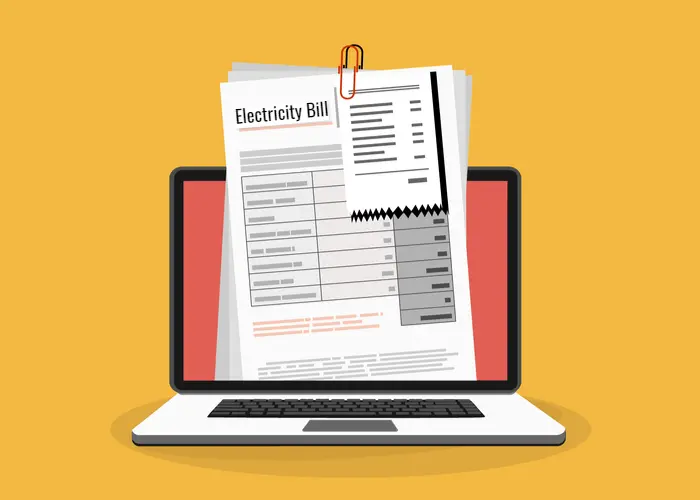Are there ways to save on your business electricity bill? Doing so starts with understanding what makes up your commecial electricity bill. Across all types of energy markets, commercial electricity bills typically have three sections – delivery charges, supply charges and demand charges.
Learning more about each can help you cut your business’ electricity bill. and this helpful guide on reading your business’s electricity bill is a great foundation
How Does a Business Electricity Bill Work?
Especially in deregulated markets, a business electricity bill isn’t as straightforward as electricity used multiplied by kilowatt-hours (kWh). Instead, you’ll pay for electricity consumption (called demand), which is priced per kilowatt, supply which is priced per kilowatt hour, and delivery, which could be volumetric and a fixed fee.
Based on the state, you may receive one utility bill with all charges or a separate electricity supply bill from your retail electric provider. Or you may receive a single bill from your electricity supplier.
What are the Charges on a Commercial Electricity Bill?
There are typically three sections on your commercial electricity bill.
- Electricity Supply Charges: the cost for the amount of electricity you consume (kWh)
- Delivery Charges: the cost to deliver electricity to your location. These are charges from your local utility.
- Demand Charges: the cost to maintain a consistent level of power across the grid. These are charges from your local utility.
Electricity supply charges are based on the amount of electricity used. This is measured in kilowatt-hours (kWh), multiplied by the rate per kilowatt-hour you have contracted for. In Texas, you can shop for business electricity rates from multiple suppliers to get the best price per kWh. And you can use our energy usage calculator if you want to track what various equipment and appliances in your business use. That can help you cut this part of your bill too.
Delivery charges cover the poles, wires and infrastructure. You will typically see both a monthly customer charge plus charges based on the amount of electricity used. Your demand determines your delivery charge rate class.
Demand is the rate at which energy is delivered to an electrical load and is measured either in kilowatts (KW) or kilovolt-amperes (kVA).
You can find the current TDU commercial delivery charges on our site.

Delivery Charges (TDSP Charges) on Commercial Electricity Bills
TDSP Charges can account for 50% or more of your company’s electricity bill. Yet, it’s the section of your electricity bill that you have the least control over.
While there are many electricity companies for your supply, only one company, your local utility, delivers that electricity. Your local Texas utility company is often referred to as TDSP (Transmission/Distribution Service Providers). Here’s a little insight into commercial electricity utility charges.
TDSP Charges – Approval Process
Each electric utility has a tariff that establishes TSDP charges. The Public Utility Commission of Texas (PUCT) approves these rate filings.
Twice per year, in March and September, the four major utilities in Texas (AEP, Oncor, CenterPoint and TNMP) file with the PUCT to revise their tariffs. These revisions account for their updated transmission and delivery costs.
Tariff increases can be associated with investments needed to improve transmission lines. Increases may also be needed to accommodate new sources of electricity generation entering the grid.
TDSP Commercial Rate Class (Tariff)
Your TDSP charges are based on your commercial rate class. Your TDSP assigns your utility rate class based on the type of meter, usage and demand.
Here are the tariff categories in Texas. Most businesses fall into the first 2 categories.
- Secondary Service Greater than 10 kVA
- Secondary Service Less than 10 kVA
- Primary Service
- Lighting Service
kVA stands for Kilo Volt Amperes, and this is a measurement of electricity demand. One kVA equals 1,000 Watts of power. KW or kilowatt is another measure of demand and also equals 1,000 Watts of power.
TDSP Charges Line Items on Bill
Your commercial electricity bill in Texas is further complicated by the number of line items you see on the bill. Most residential electricity bills have just two TDSP charges on the bill, one for monthly customer charge and the other for volumetric delivery charges.
A commercial electricity bill in Texas typically details the TDSP charges for your company. So you will see line items that may include the following:
- Customer Charge
- Metering Charge
- Distribution System Charge
- Transmission System Charge
- Nuclear Decommissioning Charge
- Transmission Cost Recovery Factor
- Transition Charges
Avoiding Commercial TDSP Charges
Sorry but…you cannot avoid TDSP charges for your commercial electricity bill. There are no competitive delivery options outside of the utility.
Additionally, TDSP charges will be the same for your business regardless of the Retail Electricity Supplier (REP) that you choose for electricity supply. So while switching to a new REP may lower the supply costs on your bill, that won’t change the TDSP charges.
Reducing Commercial TDSP Charges
While you can’t avoid TDSP charges on your commercial bill, you can take steps to reduce them.
Your total delivery charges are volumetric. That means the more you use, the more your total bill. Cut your usage and cut your delivery charges.
Your delivery charges are also based on your demand and meter type. In the next section we’ll talk about demand charges and total demand.
Important Takeaways on Texas Commercial TDSP Charges on your Bill:
(1) Everyone pays TDSP delivery charges regardless of supplier. You can’t avoid paying delivery charges for your commercial electricity.
(2) TDSP fees change twice a year and are approved by the Public Utility Commission of Texas
(3) Your TDSP rate class or tariff is based on your meter type, usage and demand
(4) Lower your commercial TDSP charges by lowering your usage and controlling your electricity demand.
What are Demand TDSP Charges on Commercial Electricity Bills?
Demand charges from the TDSP are based on the amount of electricity that is used by your business during times of the year when the electricity demand and usage are at their maximums.
In Texas (ERCOT market area) your peak demand charge is based on your peak usage during the Four Coincident Peaks, or 4CP. These are the 4 15-minute periods with the highest usage during each month of summer, June – September.
Higher electricity usage during peak demand generates higher demand side charges on an electricity invoice. Plus, your demand helps determine which delivery tariff (rate class) you fall under.
Managing your demand can help lower your bill in three ways.
- First, you’ll maintain your company in a specific rate class.
- Second, controlling your demand can lower your demand charges.
- Third, REPs charge different rates for business electricity supply based on your demand.
>>For an in-depth look at demand charges and load factor, check out our full article on that topic!
Important Takeaways on Texas Commercial Demand Charges on your Bill:
(1) Demand charges represent maximum usage level.
(2) Your demand impacts your rate class for delivery charges.
(3) Your demand impacts your electricity supply rate.
4) You can control your demand charges by being proactive in energy management.
Lower Your Demand and Lower your Business Electricity Bill
While there are no options to choose a different delivery utility, you can take steps to lower TDSP charges. It all starts with how and when you use your electricity.
Lower your usage and lower your demand, and you can lower your electricity bill.
Here are some ways to cut your demand:
- If you have large pieces of equipment or multiple air conditioners, consider staging their start-up times.
- Avoid turning on all large equipment at once. This is the most common culprit for setting your peak demand.
- Other tips include adjustments to thermostat set points. It is important to set thermostats in a way that parallels the operating hours of a business. Raising thermostat set points in the summer and lowering them in the winter by a degree or two reduces heating and cooling loads.
- Another opportunity for cost savings is during the summer when air conditioning load and electricity demands are at their highest levels.
- Taking proactive steps to intentionally reduce electricity usage during these periods of peak demand will translate into lower demand charges.
While most smaller businesses do not have interval meters (IDR Meters), those that do have additional opportunities to reduce demand charges by participating in peak load management programs.
Additionally, it is also important to be sure that the REP supplying the electricity is passing-through TDSP charges at cost and not marking up those charges. Rest assured that all business plans offered on ElectricityPlans.com are passing through TDSP charges at cost.
If your commercial meter records interval data and you’d like to learn more about how you can mitigate your risk and develop a demand side strategy, call us at 844-214-5559.
